
ユダヤ人頭骨コレクション
Jewish skull collection

☆ ユダヤ人の頭蓋骨コレクションは、ナチスがアーリア人の超人類と見なしたドイツ民族とは対照的に、「ユダヤ民族」の人種的劣等性を示す人類学的な展示物を 作り、ユダヤ人がウンターメンヒェン(亜人)であることを強調しようとしたものだった。このコレクションは、併合されたアルザス地方にある帝国ストラス ブール大学の解剖学研究所に収容されることになっており、そこで死体の最初の準備が行われた。
| The
Jewish skull collection was an attempt by the Nazis to create an
anthropological display to showcase the alleged racial inferiority of
the "Jewish race" and to emphasize the Jews' status as Untermenschen
("sub-humans"), in contrast to the German race, which the Nazis
considered to be Aryan Übermenschen ("superhumans"). The collection was
to be housed at the Anatomy Institute at the Reich University of
Strasbourg in the annexed region of Alsace, where the initial
preparation of the corpses was performed. The collection was sanctioned by Reichsführer-SS Heinrich Himmler, and designed by and under the direction of August Hirt with Rudolf Brandt and Wolfram Sievers, general manager of the Ahnenerbe, being responsible for procuring and preparing the corpses. Work by Hans-Joachim Lang published in 2004 revealed the identities and family history of all the victims of this project, based on discovery of the prisoner numbers found at Natzweiler-Struthof in records of those vaccinated against typhus at Auschwitz. The list of names has been placed on a memorial at the cemetery where all were buried, at the facility used to murder them[citation needed], and at the Anatomical Institute where the corpses were found in 1944. |
ユ
ダヤ人の頭蓋骨コレクションは、ナチスがアーリア人の超人類と見なしたドイツ民族とは対照的に、「ユダヤ民族」の人種的劣等性を示す人類学的な展示物を作
り、ユダヤ人がウンターメンヒェン(亜人)であることを強調しようとしたものだった。このコレクションは、併合されたアルザス地方にある帝国ストラスブー
ル大学の解剖学研究所に収容されることになっており、そこで死体の最初の準備が行われた。 このコレクションはハインリッヒ・ヒムラー親衛隊大総統によって認可され、アウグスト・ヒルトの指揮のもとで設計され、ルドルフ・ブラントとアーネンナーベの総支配人ヴォルフラム・シーヴァースが死体の調達と準備を担当した。 2004年に発表されたハンス・ヨアヒム・ラングの研究によって、アウシュヴィッツでチフスの予防接種を受けた人々の記録から、ナッツヴァイラー・シュト ルートホーフで発見された囚人番号に基づいて、このプロジェクトの犠牲者全員の身元と家族歴が明らかになった。この名簿は、全員が埋葬された墓地、殺害に 使われた施設[要出典]、1944年に死体が発見された解剖学研究所の記念碑に掲載されている。 |
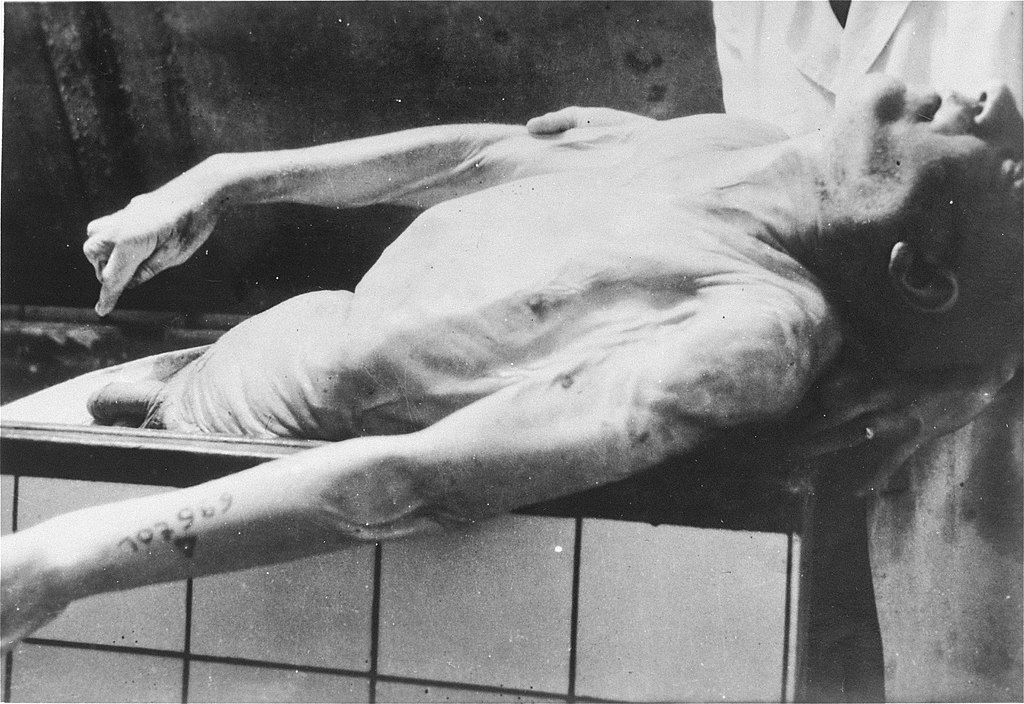 Menachem Taffel's body, part of the Jewish skeleton collection Menachem Taffel's body, part of the Jewish skeleton collection出生:1900年7月28日(Sedzislow, Poland);死亡:1943年8月19日Camp de concentration du Struthof, Natzwiller, Bas-Rhin, France. |
・ベルリンの乳製品商メナケム・タッフェルの死体。1943年3月、アウシュヴィッツに妻子とともに強制送還され、到着後ガス処刑された。ユダヤ人骨格コレクションの解剖標本に選ばれ、ナッツヴァイラー・シュトルートホーフに送られ、1943年8月にガス室で殺された。 ・第二次世界大戦中にナチスの実験に使われた数十人のユダヤ人の遺骨が、ストラスブールの研究所で保管されているのが発見された by MailOnline, 7 September 2015. ・Menachem Taffel's body, part of the Jewish skeleton collection - サディスティックなナチス医師によってバラバラにされる前に妻子をガス処刑されたアウシュビッツの犠牲者の漬物状の遺骨が、72年後にようやく安置される by MailOnline, 8 September 2015. |
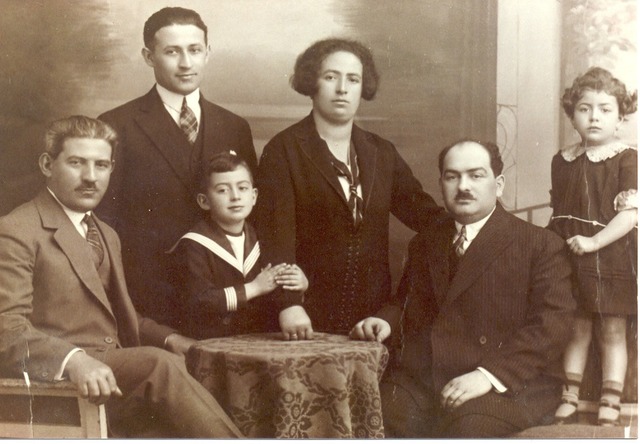 |
Menachem Max Taffel(撮影は1927年) Birthdate: 1900年7月21日(※上掲では28日) Birthplace: Sędziszów, świętokrzyskie, Poland Death: 1943年8月19日 (43) Natzwiller, Grand Est, France 近親者: Arieh Taffel , Ita Taffel の息子 Klara Taffel の夫 Ester Ottilie Taffel の父 Israel Taffel の兄弟 Managed by: Dan Bodenheimer (Cousin Detective) |
Selection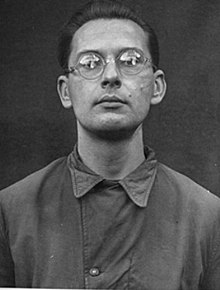 Mugshot of Rudolf Brandt, c. 1946 The project was designed by August Hirt, who directed the phases that were performed before the end of the war ended the project prior to its completion. Originally the "specimens" to be used in the collection were to be Jewish commisars in the Red Army captured on the Eastern front by the Wehrmacht. The 86 individuals ultimately chosen for the collection were obtained from among a pool of 115 Jewish inmates at Auschwitz concentration camp in Occupied Poland. They were chosen for their perceived stereotypical racial characteristics. The initial selections and preparations were carried out by SS-Hauptsturmführer Bruno Beger and Hans Fleischhacker, who arrived in Auschwitz in the first half of 1943 and finished the preliminary work by June 15, 1943.[citation needed] Due to a typhus epidemic at Auschwitz, the candidates chosen for the skeleton collection were quarantined in order to prevent them from becoming ill and ruining their value as anatomical specimens. In that time, the physical measurements were taken from the selected group of people. An excerpt from a letter written by Sievers in June 1943 reports on the preparation and the typhus epidemic: "Altogether 115 persons were worked on, 79 were Jews, 30 were Jewesses, 2 were Poles, and 4 were Asiatics. At the present time these prisoners are segregated by sex and are under quarantine in the two hospital buildings of Auschwitz." In February 1942, Sievers submitted to Himmler, through Rudolf Brandt, a report from which the following is an extract read at the Nuremberg Doctors Trial by General Telford Taylor, Chief Counsel for the prosecution at Nuremberg[citation needed]: We have a nearly complete collection of skulls of all races and peoples at our disposal. Only very few specimens of skulls of the Jewish race, however, are available with the result that it is impossible to arrive at precise conclusions from examining them. The war in the East now presents us with the opportunity to overcome this deficiency. By procuring the skulls of the Jewish-Bolshevik Commissars, who represent the prototype of the repulsive, but characteristic subhuman, we have the chance now to obtain a palpable, scientific document. The best, practical method for obtaining and collecting this skull material could be handled by directing the Wehrmacht to turn over alive all captured Jewish-Bolshevik Commissars to the Field Police. They in turn are to be given special directives to inform a certain office at regular intervals of the number and place of detention of these captured Jews and to give them special close attention and care until a special delegate arrives. This special delegate, who will be in charge of securing the "material" has the job of taking a series of previously established photographs, anthropological measurements, and in addition has to determine, as far as possible, the background, date of birth, and other personal data of the prisoner. Following the subsequently induced death of the Jew, whose head should not be damaged, the delegate will separate the head from the body and will forward it to its proper point of destination in a hermetically sealed tin can especially produced for this purpose and filled with a conserving fluid. Having arrived at the laboratory, the comparison tests and anatomical research on the skull, as well as determination of the race membership of pathological features of the skull form, the form and size of the brain, etc., can proceed. The basis of these studies will be the photos, measurements, and other data supplied on the head, and finally the tests of the skull itself.[citation needed] |
セレクション ルドルフ・ブラントの顔写真(マグショット)、1946年頃 このプロジェクトはアウグスト・ヒルトによって設計され、終戦前に実行された段階を指揮 した。当初、コレクションに使用される「標本」は、ドイツ国防軍によって東部戦線で捕らえられた赤軍のユダヤ人徴用兵であった。最終的にコレクションに選 ばれた86人は、占領下のポーランドにあるアウシュビッツ強制収容所の115人のユダヤ人収容者の中から集められた。彼らは、ステレオタイプ的な人種的特 徴を認識した上で選ばれた。最初の選別と準備は、1943年前半にアウシュヴィッツに到着し、1943年6月15日までに予備作業を終えたブルーノ・ベーガー親衛隊長とハンス・フライシュハッカーによって行われた[要出典]。 アウシュヴィッツではチフスが流行していたため、骨格標本に選ばれた候補者は、病気になって解剖標本としての価値が損なわれるのを防ぐために隔離された。 その間に、選ばれた人々の身体測定が行われた。1943年6月にシーヴァースが書いた手紙からの抜粋は、その準備とチフスの流行について報告している: 「全部で115名が作業され、79名がユダヤ人、30名がユダヤ人女性、2名がポーランド人、4名がアジア人であった。現在、これらの囚人は男女別に隔離 され、アウシュヴィッツの2つの病院棟で隔離されている。" 1942年2月、シーヴァースは、ルドルフ・ブラントを通じて、ヒムラーに報告書を提出した。この報告書からの抜粋は、ニュルンベルクでの検事側首席弁護 人テルフォード・テイラー将軍がニュルンベルク医師裁判で読み上げたものである[citation needed]: われわれは、あらゆる人種と民族の頭蓋骨をほぼ完全にコレクションして いる。しかし、ユダヤ民族の頭骨標本はごくわずかしかなく、その結果、それらを調べても正確な結論を導き出すことは不可能である。東方における戦争は、こ の欠乏を克服する機会をわれわれに与えてくれる。反吐が出るような、しかし特徴的な亜人の原型を示すユダヤ人・ボリシェヴィキコミッサーの頭蓋骨を入手す ることによって、われわれは今、明白な科学的資料を手に入れるチャンスを得たのである。 この頭蓋骨資料を入手・収集するための最良の実際的方法は、ドイツ国防 軍に命じて、捕虜にしたすべてのユダヤ人・ボリシェヴィキ共産主義者を生きたまま野戦警察に引き渡させることである。そして、捕虜となったユダヤ人の数と 拘留場所を定期的にある事務所に報告し、特別代表が到着するまで特別に細心の注意を払い、世話をするようにとの特別指令を与えるのである。この特別代表 は、「資料」の確保を担当し、事前に設定された一連の写真撮影、人類学的測定を行い、さらに、囚人の経歴、生年月日、その他の個人データを可能な限り特定 しなければならない。その後、頭部が損傷しないように誘導されたユダヤ人の死後、代表者は頭部と遺体を分離し、この目的のために特別に製造され、保存液で 満たされた密閉されたブリキ缶に入れて、適切な目的地に送る。 研究所に到着したら、頭蓋骨の比較試験と解剖学的研究、頭蓋骨の形、脳の形と大きさなどの病理学的特徴の人種構成員の判定を進めることができる。これらの 研究の基礎となるのは、提供された頭部の写真、寸法、その他のデータであり、最終的には頭蓋骨そのもののテストとなる[要出典]。 |
Preparation Natzweiler-Struthof Ultimately, 87 of the inmates were shipped to Natzweiler-Struthof. These people were kept for about two weeks in Block 13 of the camp so that they might eat well to improve their appearance for the desired casts of their corpses. The deaths of 86 of these inmates were, in the words of Hirt, "induced" in an improvised gassing facility at Natzweiler-Struthof, and their corpses were sent to Strasbourg — 57 men and 29 women. The gassing occurred on August 11, 13, 17, and 19, conducted by commandant Josef Kramer, who directed the victims to undress, placed the poison in the ventilation, and watched the people fall to their deaths. One victim was shot for fighting to avoid being gassed and thus was not part of the collection.[1] Josef Kramer, acting commandant of Natzweiler-Struthof (who became the commandant at Auschwitz and the last commandant of Bergen Belsen), personally carried out the gassing of the victims, per his testimony at his post-war trial. It is believed that three men died in transport from Auschwitz to Natzweiler-Struthof.[2] 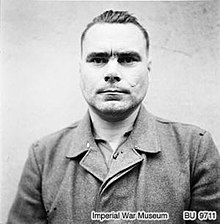 Josef Kramer, 1907-1945 The next part of the process for this "collection" was to make anatomical casts of the bodies prior to reducing them to skeletons. With the approach of the Allies in 1944, there was concern over the possibility that the corpses could be discovered, as they had still not been defleshed. In September 1944, Sievers telegrammed Brandt: "The collection can be defleshed and rendered unrecognizable. This, however, would mean that the whole work had been done for nothing – at least in part – and that this singular collection would be lost to science, since it would be impossible to make plaster casts afterwards."[citation needed] Some work had been done at the Anatomical Institute, but the project was never completed. The body casts were not made, and the corpses were not defleshed as skeletons. When the Allies arrived, they found the corpses, some complete and some beheaded, preserved by formalin.[3] |
準備 ナッツヴァイラー・シュトルートホーフ 最終的に、87名の収容者がナッツヴァイラー・シュトルートホーフに送られた。これらの収容者は、収容所のブロック13に2週間ほど収容され、死体のギプ スを作るために、外見をよくするために、よく食べるようにされた。これらの収容者のうち86名は、ヒルトの言葉を借りれば、ナッツヴァイラー・シュトルー トホーフの即席ガス処刑施設で「誘導」され、その死体は、男性57名、女性29名とともに、ストラスブールに送られた。ガス処刑は8月11日、13日、 17日、19日に行われ、指揮官ヨーゼフ・クラマーが犠牲者に服を脱ぐように指示し、換気口に毒を入れ、人々が死に落ちるのを見届けた。ナッツヴァイ ラー・シュトルートホーフの司令官代理であったヨーゼフ・クラマー(アウシュヴィッツの司令官となり、ベルゲン・ベルゼンの最後の司令官となった)は、戦 後の裁判での証言によると、犠牲者のガス処刑を個人的に実行した。アウシュヴィッツからナッツヴァイラー=シュトルートホーフへの移送中に3人が死亡した と考えられている[2]。  ヨーゼフ・クラーマー(Josef Kramer, 1907-1945) この「収集」の次の工程は、遺体を骨格標本にする前に、解剖学的ギプスを作ることであった。1944年、連合国軍の接近に伴い、死体はまだ脱骨されていな かったため、発見される可能性が懸念された。1944年9月、シーヴァースはブラントに電報を打った。しかし、このことは、少なくとも部分的には、すべて の作業が無駄に終わったことを意味し、石膏模型を作ることは不可能であるため、この特異なコレクションは科学から失われることになる」[要出典]。 解剖学研究所ではいくつかの作業が行われていたが、このプロジェクトが完成することはなかった。遺体のギプスは作られず、死体は骨格標本として解体されなかった。連合国軍が到着したとき、彼らはホルマリン漬けにされた完全な死体や斬首された死体を発見した[3]。 |
Aftermath Memorial plaque at the Institute of Anatomy, University of Strasbourg 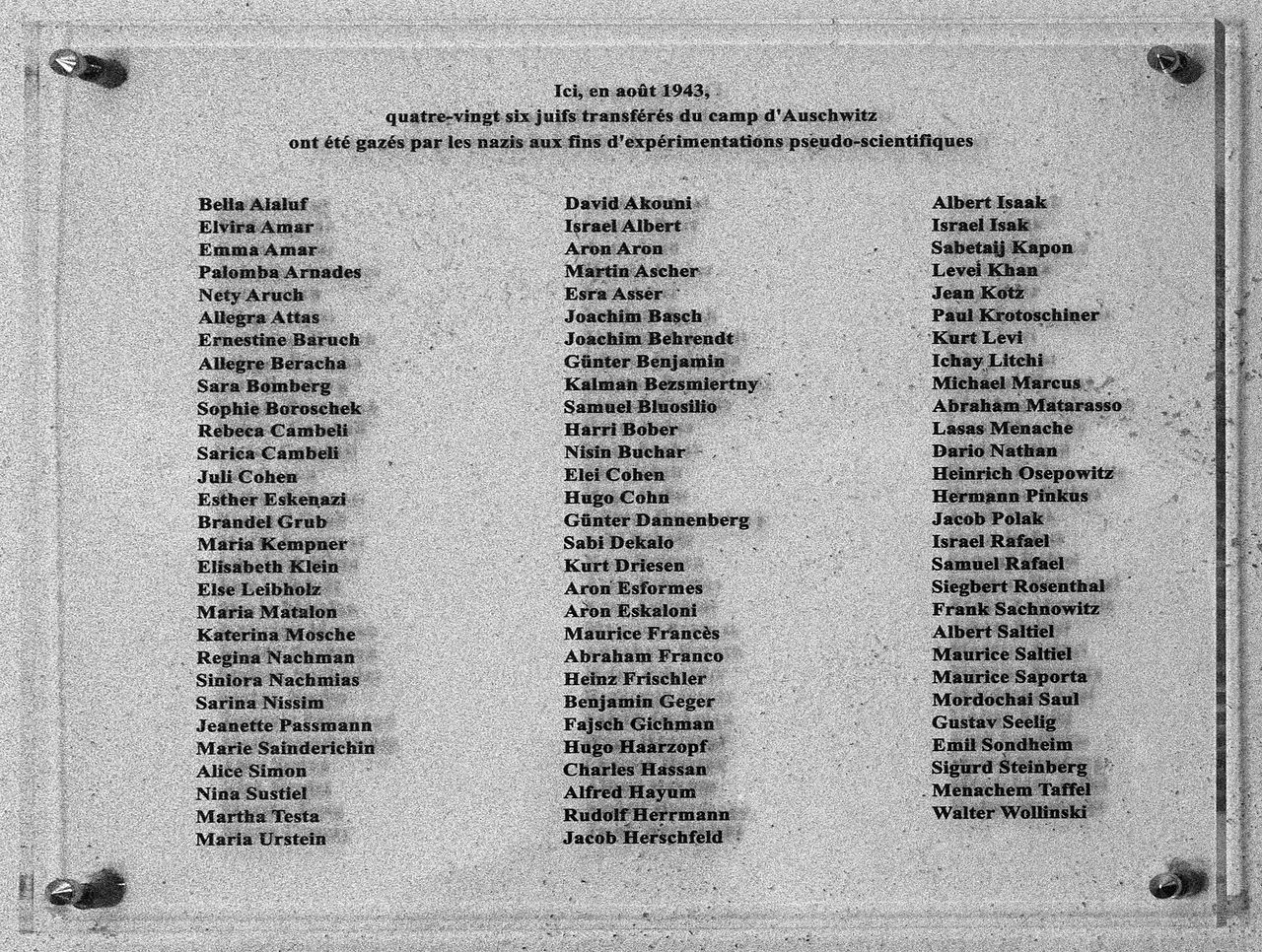 Memorial plaque with names of the victims outside of the gas chamber at Natzweiler-Struthof Concentration Camp Brandt and Sievers were indicted, tried, and convicted in the Doctors' Trial in Nuremberg, and both were hanged in Landsberg Prison on June 2, 1948. Josef Kramer was convicted of war crimes and hanged at Hamelin Prison by British executioner Albert Pierrepoint on December 13, 1945. August Hirt, who conceived the project, was sentenced to death in absentia at the Military War Crimes Trial at Metz on 23 December 1953.[4] It was unknown at the time that Hirt had shot himself in the head on June 2, 1945, near the town of Schluchsee, while hiding in the Black Forest.[4] In 1974, Bruno Beger was convicted by a West German court as an accessory to 86 murders for his role in procuring the victims of the Jewish skeleton collection. He was sentenced to three years imprisonment, the minimum sentence, but did not serve any time in prison, after being given credit for time served. According to his family, Beger died in Königstein im Taunus on October 12, 2009.[5][6][7][8] For many years, only a single victim was positively identified through the efforts of Serge and Beate Klarsfeld: Menachem Taffel (prisoner no. 107969), a Polish born Jew who had been living in Berlin. In 2003, Hans-Joachim Lang, a German professor at the University of Tübingen, succeeded in identifying all the victims by comparing a list of inmate numbers of the 86 corpses at the Reichs University in Strasbourg, surreptitiously recorded by Hirt's French assistant Henri Henrypierre, with a list of numbers of inmates vaccinated at Auschwitz. The names and biographical information of the victims were published in the book Die Namen der Nummern (The Names of the Numbers).[9] Rachel Gordon and Joachim Zepelin translated the Introduction to the book into English at the web site where the whole book is posted in German, including the biographies of the 86 people.[10] Lang recounts in detail the story of how he determined the identities of the 86 victims gassed for Dr. August Hirt's project of the Jewish skeleton collection. Forty-six of these individuals were originally from Thessaloniki, Greece. The 86 were from eight countries in German-occupied Europe: Austria, Netherlands, France, Germany, Greece, Norway, Belgium, and Poland.[4][11][12] In 1951, the remains of the 86 victims were re-interred in one location in the Cronenbourg-Strasbourg Jewish Cemetery. On December 11, 2005, memorial stones engraved with the names of the 86 victims were placed at the cemetery. One is at the site of the mass grave, the other along the wall of the cemetery. Another plaque honoring the victims was placed outside the Anatomy Institute at Strasbourg's University Hospital. On July 9, 2015, French doctor Raphael Toledano discovered at the Forensic Institute's Museum of Strasbourg several tissue samples hidden away, presumed to be from Menachem Taffel.[13][14] These last remains were buried in the Jewish cemetery of Cronenbourg on September 6, 2015.[15][16] As journalist and researcher Lang stated, once his long research was published on the identities of the 86 people killed under Hirt's orders, "The perpetrators should not be allowed to have the final word."[3] |
余波 ストラスブール大学解剖学研究所の記念プレート  ナッツヴァイラー・シュトルートホフ強制収容所のガス室の外にある犠牲者の名前を記した記念プレート ブラントとシーヴァースは、ニュルンベルクの医師裁判で起訴され、裁判にかけられ、有罪判決を受け、1948年6月2日、ランツベルク刑務所で絞首刑と なった。ヨゼフ・クラマーは戦争犯罪で有罪判決を受け、1945年12月13日、イギリスの死刑執行人アルバート・ピエールポイントによってハーメルン刑 務所で絞首刑に処された。このプロジェクトを発案したアウグスト・ヒルトは、1953年12月23日にメッツで開かれた軍事戦争犯罪裁判で欠席裁判による 死刑判決を受けた[4]。当時は、ヒルトが1945年6月2日に黒い森に潜伏していたときにシュリュクゼーの町の近くで自分の頭を撃ったことは知られてい なかった[4]。 1974年、ブルーノ・ベーガーは、ユダヤ人の骸骨収集の犠牲者を調達する役割を果たしたとして、86件の殺人の共犯者として西ドイツの裁判所に有罪判決 を受けた。彼は最低刑である禁固3年の判決を受けたが、服役期間が認められたため服役はしなかった。彼の家族によれば、ベガーは2009年10月12日に ケーニヒシュタイン・イム・タウヌスで死亡した[5][6][7][8]。 何年もの間、セルジュとベアテ・クラルスフェルドの努力によって、たった一人の犠牲者の身元が確認された: ベルリンに住んでいたポーランド生まれのユダヤ人、メナケム・タフェル(囚人番号107969)である。2003年、チュービンゲン大学のドイツ人教授ハ ンス=ヨアヒム・ラングは、ヒルトのフランス人助手アンリ・アンリピエールが密かに記録した、ストラスブールの帝国大学の86名の死体の収容者番号のリス トと、アウシュヴィッツで予防接種を受けた収容者の番号のリストとを比較することによって、すべての犠牲者の同定に成功した。犠牲者の名前と略歴は、『数 字の名前』(Die Namen der Nummern)という本に掲載された[9]。レイチェル・ゴードンとヨアヒム・ツェペリンは、86人の略歴を含む本全体がドイツ語で掲載されているウェ ブサイトで、この本の序文を英語に翻訳した[10]。 ラングは、アウグスト・ヒルト博士のユダヤ人骨格コレクションのプロジェクトのために、どのようにしてガス処刑された86人の犠牲者の身元を突き止めたか を詳細に語っている。このうち46人はギリシャのテッサロニキ出身であった。86人の出身国はドイツ占領下のヨーロッパ8カ国であった: オーストリア、オランダ、フランス、ドイツ、ギリシャ、ノルウェー、ベルギー、ポーランドである[4][11][12]。 1951年、86人の犠牲者の遺骨はクローネンブール=ストラスブール・ユダヤ人墓地の一箇所に再び埋葬された。2005年12月11日、86人の犠牲者 の名前が刻まれた記念碑が墓地に設置された。ひとつは集団墓地跡に、もうひとつは墓地の壁に沿って設置された。また、ストラスブール大学病院の解剖学研究 所の外にも犠牲者を称えるプレートが設置された。2015年7月9日、フランス人医師ラファエル・トレダノがストラスブールの法医学研究所博物館で、メナ ケム・タフェルのものと推定されるいくつかの組織サンプルが隠されているのを発見した[13][14]。これらの最後の遺骨は2015年9月6日にクロー ネンブールのユダヤ人墓地に埋葬された[15][16]。 ジャーナリストであり研究者であるラングが述べているように、ヒルトの命令で殺された86人の身元に関する彼の長年の研究が公表されると、「加害者が最後の言葉を持つことは許されるべきではない」[3]。 |
| Ahnenerbe Bullenhuser Damm Kaiser Wilhelm Institute of Anthropology, Human Heredity, and Eugenics Nazi human experimentation Research Materials: Max Planck Society Archive |
アーネンエアベ ブレンフーザー・ダム カイザー・ヴィルヘルム人類学・人類遺伝学・優生学研究所 ナチスの人体実験 研究資料 マックス・プランク協会アーカイブ |
| https://en.wikipedia.org/wiki/Jewish_skull_collection |
|
リ ンク
文 献
そ の他の情報
Copyleft, CC, Mitzub'ixi Quq Chi'j, 1996-2099
☆
 ☆
☆